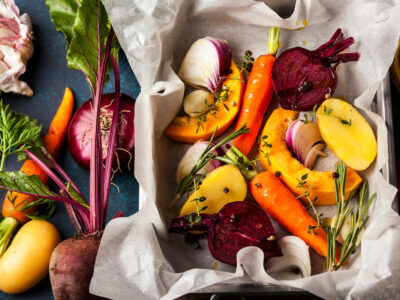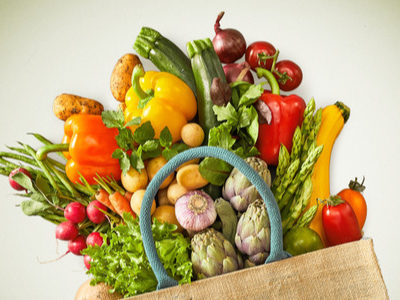Table of Contents[Hide][Show]
When you think of seasonal eating, a few images might come easily to mind:
Just-ripe strawberries straight from the farmer’s market…
Fresh, grilled corn at your summer gatherings…
Refreshing smoothies made with mouth-watering tropical fruits and veggies…
But what happens in the winter? When there’s frost on the ground and your favorite fruits are out of season?
Yes, you can still eat seasonally in the winter, and we’ll explain how you can (and why you should!) in this post.
What Is Seasonal Eating?
Seasonal eating is just what its name implies: eating food that’s in season, during all four seasons of the year.
When you’re eating seasonally, you’re letting Mother Nature and geography choose your foods for you.
It’s a delicious approach to food, since flavors are usually at their peak right at harvest time. The food is fresher, tastier, and contains more nutrients.
And while some people think of seasonal eating as being limiting, the opposite is actually quite true.
Seasonal eating is a wonderful way to open your mind, explore new recipes, and fall in love with new flavors.
You don’t have to limit yourself with seasonal foods. Instead, you have the opportunity to expand your palate and discover a wider variety of foods.
And there are important benefits to seasonal eating. Let’s look at some of them.
Related
7 Ways to Enrich Your Life Through Seasonal Living
Discover the practice of season living! Learn to live in sync with the seasons through food, nature, gardening, moon cycles, seasonal rituals, and more.
6 Benefits of Eating Seasonally
Now that you have a better understanding of seasonal eating, let’s look at why it’s important.
1. Fresher Food
Sure, those tropical bananas in the grocery store in the middle of winter are tempting. But unless you’re living somewhere tropical, they aren’t fresh; they were shipped to your local store from another state or another country.
To compensate for the long route to your grocery store, out-of-season produce is harvested prematurely and allowed to ripen during the shipping process.
This harms both its flavor and its nutrient density.
Fresh, in-season winter produce will be full of rich, bold flavors, and will retain more of the vitamins, minerals, and other nutrients that make fruits and vegetables so healthy for you.
2. Greater Variety of Nutrients
When you have a favorite fruit or vegetable, it can quickly become a staple in your grocery cart. Week after week, you find reasons and recipes that call for your go-to produce.
And thanks to international transportation, preservatives, and other grocery technologies, chances are you can find what you’re looking for all year—or close to it.
But if you’re filling your plate with one type of food, even a healthy one, you’ll end up missing out on the other nutrients that variety provides.
Instead of choosing the same fruits and vegetables you do every week, take a moment to look at what your grocery store is offering. Read the labels to find local produce, which will be what’s in season in your area.
Stock up on great-tasting winter foods and enjoy the nutrients they bring you.
3. Save Money on Groceries
Focusing on seasonal produce that grows naturally in your area during the winter months can offer huge savings at the grocery store.
For one, farmers won’t have the added expenses of growing against the climate: preparing specialty soil, using grow lights, etc. The ease of growth and added abundance help keep costs down.
And, since your winter produce was grown and harvested locally, stores don’t have to pass along the high shipping fees incurred when produce is brought in from another climate.
So, buying seasonal produce isn’t just more nutritious. It can reduce your grocery bill by as much as 50%.
4. Protect the Environment
Selecting foods that are grown and sold locally is much better for the environment.
Whether it’s the produce harvested by area farms or meat that was butchered nearby, choosing local, seasonal foods can vastly reduce the time and resources used to transport your food.
In fact, the energy usage used to transport food is so high, that it has its own name: “food miles.”
By contrast, the food you purchase from local farmers, whether at their market or in your favorite shop, doesn’t have to be transported very far at all.
When you eat the seasons, your planet will thank you!
5. Support Local Businesses
Need more reasons to eat seasonally?
Here’s a big one: you’re keeping your money in your local economy. You’re supporting the businesses that live, work, and hire in your area.
Farmer’s markets and stands are the simplest way to support your area farmers. But many of these aren’t available in the winter.
If you’ve bought produce from a local farm or have a particular farmer’s market you frequent during the warmer months, reach out to them or check their website. They may have an on-site shop that you can visit or steer you toward any winter festivals or markets they may attend.
Even if you simply buy fresh at your local grocery store, you can still check the labels on your produce. Choose the ones that are locally produced.
Related
Locavorism: The Practice of Eating Local Foods
Is it high time for you to support local foods only? Why and how should you practice locavorism? Learn more about it here! RELATED: 10 Advantages Of Buying Local In this article: Being a Locavore: Eating Local Foods for Overall Wellness What Does It Mean to Eat Local? Every year, technology makes our world even …
6. Nourish Your Body’s Seasonal Cravings
Ever wonder why as soon as colder weather hits, you start craving heartier foods? It’s not a coincidence!
Comfort foods like soups and casseroles fulfill physical and emotional needs influenced by factors such as nostalgia, biological cravings for carbohydrate-rich foods (for energy and warmth), and psychological changes like Seasonal Affective Disorder (SAD).
Additionally, nutritional psychiatry highlights the gut’s role in producing happiness chemicals. The release of dopamine and serotonin, triggered by these foods, contributes to feelings of happiness, while the ritualistic preparation and consumption enhance mindfulness and connection to traditions.
While the foods you loved to eat as a child influences your adult cravings, you can now make healthier choices that can still provide that feeling of comfort you crave.
Embracing intuitive eating in winter is also linked to improved psychological well-being and body image, so slurp down that big bowl of soup and enjoy!
How to Eat Seasonally in the Winter
Now that you understand the reasons why eating seasonally matters, let’s look at the best ways to incorporate winter foods into your diet.
Buy Seasonal Produce
One of the simplest ways to eat the seasons is to buy only the produce that is harvested locally during that time of the year.
It’s easy to do that in the summer, with roadside stands and farmer’s markets offering just-picked fruits and vegetables, but in the winter, you may need to do a bit more research beforehand, so you can head to the grocery store with a list of winter produce.
To help you out, here’s a list of winter fruits that may be in season near you.
- Apples
- Avocados
- Bananas
- Grapefruit
- Kiwi
- Lemons
- Limes
- Oranges
- Pears
- Pineapples
And, here are some of the most common winter vegetables.
- Beets
- Brussel sprouts
- Cabbage
- Celery
- Collard Greens
- Herbs (depending on your growing zone)
- Kale
- Leeks
- Onions
- Parsnips
- Potatoes
- Pumpkin
- Rutabaga
- Sweet potatoes
- Swiss chard
- Turnips
- Winter Squashes
- Yams
You can, and should, do your research to make sure you’re eating fresh, seasonal, and local fruits and vegetables.
Grow Winter Seasonal Food at Home
You can also ensure that you’re eating seasonally by growing some of your own food. Here’s how…
Growing Winter Foods Outdoors
Outdoor gardens might be challenging, especially if you get snow or frost.
However, there are plenty of frost-resistant fruits and vegetables that are easy to grow in winter. Carrots, for example, are hardy enough to resist light frost and are often sweeter when grown in cooler weather.
A visit to your local garden center can help you figure out which seeds to buy and when to plant them.
Some crops will require a longer growing period, meaning you’ll have to plant them in summer or early fall. But other crops can be planted and grown in just a few weeks. Radishes, for example, can be harvested in as little as 3 weeks.
Growing Winter Foods Indoors
If you don’t have an outdoor garden, you can try your hand at an indoor garden.
Growing herbs is an especially easy winter gardening project, since most of them do well in pots.
Since many common herbs, such as basil, oregano, parsley, and rosemary, are from the Mediterranean, they prefer a sunny spot. Just make sure that there’s no draft and that your garden isn’t feeling any chill passing through the window glass, especially when the temperatures drop at night.
Leafy greens are another good indoor option. You can grow lettuce, arugula, spinach, and kale indoors quite easily. As long as you sow them every few weeks, you’ll have enough of these to last you all winter!
Sprouts and mushrooms are also prime candidates for an indoor winter garden. Although they’re easy to grow, inexpensive growing kits will remove any guesswork and make them even easier to grow.
Add Winter Foods to Your Home-Cooked Meals
Now that you have two effective ways to gather seasonal produce during winter, it’s time to use it in your favorite meals.
The best foods to eat in winter are comfortingly warm, hearty meals that leave you feeling cozy and full. Think soups, broths, roasts, and casseroles.
Luckily, those fresh winter veggies are perfect for soups and broths. Butternut squash, pumpkin, spinach, and other winter vegetables are especially nutrient-dense, delicious additions to your homemade soups.
Your winter root vegetables, including beets, carrots, and sweet potatoes, can be oven-roasted for a savory, nutritious side dish.
Many fruits can also be cooked, either by themselves or added to your favorite baking recipes, for a fresh dose of flavor—and nutrients. Grilled or baked fruits are an especially tasty dessert on their own.
Finally, those mushrooms and herbs can be used to heighten the flavor of everything from sandwiches to salads to cooked dishes. And sprouts give your favorite sandwich or salad a satisfying crunch!
Final Thoughts
Eating seasonally is one of the best choices you can make for your body, your wallet, and the environment.
And, it’s easy to do.
Simply choose foods that are in season and local to your area. Then use them in your favorite recipes—or let them inspire new ones!
You May Also Like…







